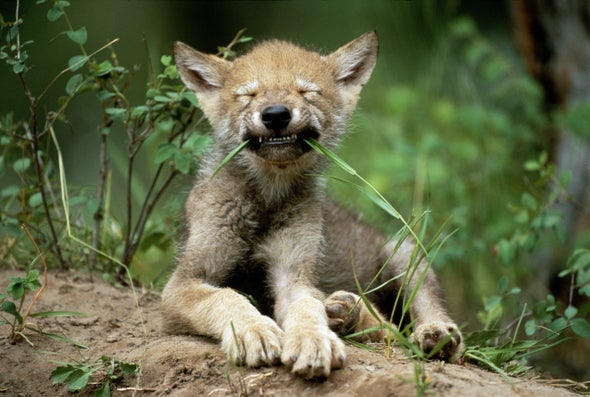(单词翻译:单击)
听力文本
This is Scientific American's 60-second Science. I'm Karen Hopkin.
It may be one of the doggone doggiest things a doggy can do...
(CLIP: Dog running and dropping a stick)
...chasing down a stick or a ball and then bringing it back.
But when it comes to playing fetch, perhaps the apple doesn't fall all that far from the evolutionary tree, because a new study shows that some wolf pups demonstrate the same innate fetching skill—a finding that suggests that an ability to playfully interact with people might have been around in ancient wolves before they transitioned into domesticated dogs some 15,000 years ago. The work is in the journal iScience.
Researchers were interested in understanding how domestication affected canine behavior. So they raised several litters of both wolf and dog puppies and ran the little fur balls through a standard series of behavioral tests.
In one of those tests, a "puppy assessor"—someone the animals never before met—would toss a tennis ball across the room and encourage the pup to retrieve it.

Wolf pups in the first two litters tested showed little interest in playing ball. But three of the six pups in the third litter caught on quickly. Two wolves named Elvis and Lenny brought the ball back in two out of three throws, while the intrepid little Sting knocked it out of the park—and carried the ball back all three times.
These results were actually unexpected. The researchers had thought that the ability to socially engage with unfamiliar humans was something that likely arose after dogs were domesticated. The fact that a few of the wolf pups were up for some fun suggests that the potential for a connection between canines and people could have been present from the get-go, giving some wolves a leg up—or maybe even multiple legs up—in becoming our best friends.
For Scientific American's 60-second Science. I'm Karen Hopkin.
参考译文
这里是科学美国人——60秒科学。我是凯伦·霍普金。
这可能是狗狗能做的最像狗的事情之一。
(音频片段:狗狗奔跑和丢棍子)
……追棍子或球,然后叼回来。
但说到取回物体的能力,也许狗狗与其祖先的差别并没有那么大,因为一项新研究表明,有些幼狼也表现出了相同的与生俱来的取物能力,这一发现表明,古代狼在大约1.5万年前转化为家犬之前,可能就具有了与人类互动玩耍的能力。这项研究发表在《iScience》期刊上。
研究人员非常想了解驯化对犬类行为的影响。因此,他们饲养了几窝小狼和小狗,并用小毛球进行了一系列标准的行为测试。
在其中一个测试中,“小狗评审员”——这些动物从未见过的人——会将网球扔到房间另一头,然后鼓励它们取回来。
头两窝被测试的小狼对玩球没有兴趣。但是第三窝的六只幼崽中,有三只迅速地叼住了球。研究人员扔了三次球,名为“埃尔维斯”和“莱尼”的两只小狼叼回来两次,虽然勇敢的小“史汀”将球踢出了公园,但它三次都把球叼回来了。
这些结果相当出乎意料。研究人员原本以为,与陌生人建立社交关系,应该是狗被驯化后才产生的能力。有些幼狼会找乐子玩,这一事实证明犬类与人类建立联系的可能也许一开始就存在,这助狼群一臂之力,甚至是几臂之力,使其成为我们最好的朋友。
谢谢大家收听科学美国人——60秒科学。我是凯伦·霍普金。
译文为可可英语翻译,未经授权请勿转载!
重点讲解
重点讲解:
1. when it comes to 谈到;涉及;
When it comes to pollution, the chemical industry is a major offender.
谈到环境污染问题,化工产业是一大祸害。
2. interact with 相互交流;相互沟通;
After initiation, the youths started to interact with the older members.
入会仪式后,这些小伙子与老成员开始互动。
3. out of (表示比例)每…中;
Two out of five thought the business would be sold privately on their retirement or death.
五个人之中有两个认为公司会在他们退休或去世时被私下卖掉。
4. from the get-go 从一开始;
I told you this was a bad idea from the get-go.
一开始我就和你说这不是好主意。


